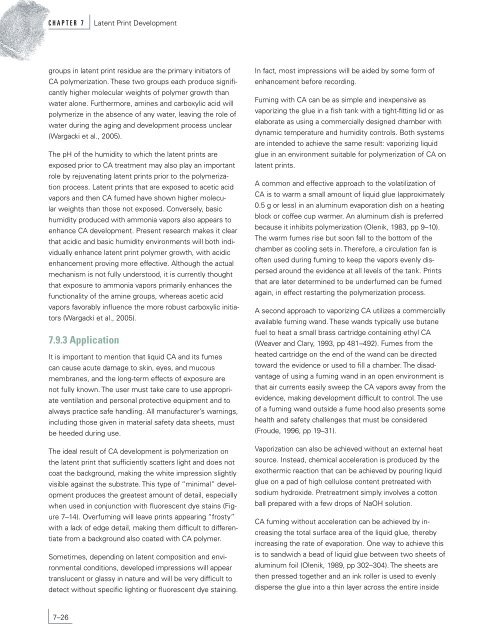Latent Print Development - National Criminal Justice Reference ...
Latent Print Development - National Criminal Justice Reference ...
Latent Print Development - National Criminal Justice Reference ...
Create successful ePaper yourself
Turn your PDF publications into a flip-book with our unique Google optimized e-Paper software.
C H A P T E R 7 <strong>Latent</strong> <strong>Print</strong> <strong>Development</strong><br />
groups in latent print residue are the primary initiators of<br />
CA polymerization. These two groups each produce significantly<br />
higher molecular weights of polymer growth than<br />
water alone. Furthermore, amines and carboxylic acid will<br />
polymerize in the absence of any water, leaving the role of<br />
water during the aging and development process unclear<br />
(Wargacki et al., 2005).<br />
The pH of the humidity to which the latent prints are<br />
exposed prior to CA treatment may also play an important<br />
role by rejuvenating latent prints prior to the polymerization<br />
process. <strong>Latent</strong> prints that are exposed to acetic acid<br />
vapors and then CA fumed have shown higher molecular<br />
weights than those not exposed. Conversely, basic<br />
humidity produced with ammonia vapors also appears to<br />
enhance CA development. Present research makes it clear<br />
that acidic and basic humidity environments will both individually<br />
enhance latent print polymer growth, with acidic<br />
enhancement proving more effective. Although the actual<br />
mechanism is not fully understood, it is currently thought<br />
that exposure to ammonia vapors primarily enhances the<br />
functionality of the amine groups, whereas acetic acid<br />
vapors favorably influence the more robust carboxylic initiators<br />
(Wargacki et al., 2005).<br />
7.9.3 Application<br />
It is important to mention that liquid CA and its fumes<br />
can cause acute damage to skin, eyes, and mucous<br />
membranes, and the long-term effects of exposure are<br />
not fully known. The user must take care to use appropriate<br />
ventilation and personal protective equipment and to<br />
always practice safe handling. All manufacturer’s warnings,<br />
including those given in material safety data sheets, must<br />
be heeded during use.<br />
The ideal result of CA development is polymerization on<br />
the latent print that sufficiently scatters light and does not<br />
coat the background, making the white impression slightly<br />
visible against the substrate. This type of “minimal” development<br />
produces the greatest amount of detail, especially<br />
when used in conjunction with fluorescent dye stains (Figure<br />
7–14). Overfuming will leave prints appearing “frosty”<br />
with a lack of edge detail, making them difficult to differentiate<br />
from a background also coated with CA polymer.<br />
Sometimes, depending on latent composition and environmental<br />
conditions, developed impressions will appear<br />
translucent or glassy in nature and will be very difficult to<br />
detect without specific lighting or fluorescent dye staining.<br />
7–26<br />
In fact, most impressions will be aided by some form of<br />
enhancement before recording.<br />
Fuming with CA can be as simple and inexpensive as<br />
vaporizing the glue in a fish tank with a tight-fitting lid or as<br />
elaborate as using a commercially designed chamber with<br />
dynamic temperature and humidity controls. Both systems<br />
are intended to achieve the same result: vaporizing liquid<br />
glue in an environment suitable for polymerization of CA on<br />
latent prints.<br />
A common and effective approach to the volatilization of<br />
CA is to warm a small amount of liquid glue (approximately<br />
0.5 g or less) in an aluminum evaporation dish on a heating<br />
block or coffee cup warmer. An aluminum dish is preferred<br />
because it inhibits polymerization (Olenik, 1983, pp 9–10).<br />
The warm fumes rise but soon fall to the bottom of the<br />
chamber as cooling sets in. Therefore, a circulation fan is<br />
often used during fuming to keep the vapors evenly dispersed<br />
around the evidence at all levels of the tank. <strong>Print</strong>s<br />
that are later determined to be underfumed can be fumed<br />
again, in effect restarting the polymerization process.<br />
A second approach to vaporizing CA utilizes a commercially<br />
available fuming wand. These wands typically use butane<br />
fuel to heat a small brass cartridge containing ethyl CA<br />
(Weaver and Clary, 1993, pp 481–492). Fumes from the<br />
heated cartridge on the end of the wand can be directed<br />
toward the evidence or used to fill a chamber. The disadvantage<br />
of using a fuming wand in an open environment is<br />
that air currents easily sweep the CA vapors away from the<br />
evidence, making development difficult to control. The use<br />
of a fuming wand outside a fume hood also presents some<br />
health and safety challenges that must be considered<br />
(Froude, 1996, pp 19–31).<br />
Vaporization can also be achieved without an external heat<br />
source. Instead, chemical acceleration is produced by the<br />
exothermic reaction that can be achieved by pouring liquid<br />
glue on a pad of high cellulose content pretreated with<br />
sodium hydroxide. Pretreatment simply involves a cotton<br />
ball prepared with a few drops of NaOH solution.<br />
CA fuming without acceleration can be achieved by increasing<br />
the total surface area of the liquid glue, thereby<br />
increasing the rate of evaporation. One way to achieve this<br />
is to sandwich a bead of liquid glue between two sheets of<br />
aluminum foil (Olenik, 1989, pp 302–304). The sheets are<br />
then pressed together and an ink roller is used to evenly<br />
disperse the glue into a thin layer across the entire inside

















